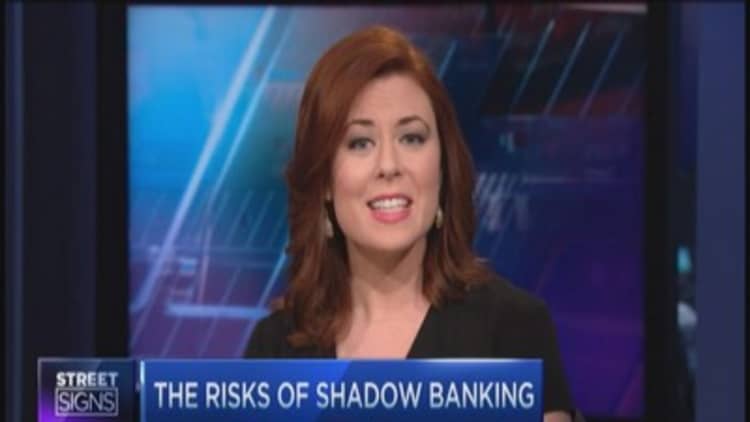
Six years since the financial meltdown, Main Street hasn't yet fully recovered and businesses are still being impacted by tighter lending standards.
Even amid historically low-interest rates, start-ups aren't rushing to traditional banks for capital. More entrepreneurs are instead turning to alternative lenders, a group of nontraditional lending options sometimes called shadow banking.
But looser lending standards for quick cash come with risks, as shadow lenders aren't regulated and related fees can be steep. Industry watchers also note easier cash can be addictive, and some entrepreneurs spiral into a vicious cycle of mounting loans.
The growing worry now among some financial experts is a repeat of circumstances that led to the 2008 meltdown. Nonbank lending was a contributing factor in the crisis, as firms lent money to low-quality borrowers, who then defaulted in droves.
"Anything in excess can create a tipping point we want to avoid," says Ralph Bumbaca, senior vice president at TD Bank in New York City. Small companies should be wary of predatory lenders. "Given the recent experience in the housing market … we don't want that to reoccur, especially in the small business sector, which is a very important economic engine for our communities," Bumbaca said.
Even JP Morgan Chase CEO Jamie Dimon is worried.
At an Institute of International Finance meeting in Washington, D.C., in October, Dimon said shadow lenders keep him up at night as "no one is paying attention" to nonbank lending.
Read MoreJamie Dimon is worried about shadow banks
"What you don't want to do is push so much risk into this nonbank financial system that that is the next thing that blows up because no one was paying attention to it, and that has happened before," Dimon told CNBC.

Nonbank lending's growth
Despite the potential risks, nonbank loans can be a lifesaver for some smaller employers.
Barbara Draves, administrator at the Surgery Center in Cleveland, Ohio, said using an alternative lender was a no-brainer.
Draves' business, devoted to outpatient surgery, had $150,000 deposited in her account in 72 hours from an alternative lender, National Funding. The business pays back National Funding $1,000 a day, which she says is easier than paying the loan back in monthly chunks.
"It's much less painful," Draves said. "I wouldn't even consider going to a bank next time."
Read MoreSmall businesses 'aren't clamoring' for enrollment
With more entrepreneurs like Draves, the nonbank financial system is estimated at $3.2 trillion in the U.S and $15 trillion globally, according to the Bank for International Settlements. The organization includes 60-member central banks from around the world.
And a key component of nonbank lending includes peer-to-peer lenders, the practice of lending money to unrelated individuals. Peer-to-peer loans are often unsecured personal loans.
The two biggest lenders in the peer-to-peer lending space are LendingClub and Prosper. The two have more than $7 billion in loan originations in about the past five years, according to Lendstats.com, a statistical analysis site that tracks data specifically for the two San Francisco-based lenders.
The global peer-to-peer lending industry is only forecast to grow further, reaching $1 trillion by 2025, according to Foundation Capital, a venture capital firm.
New players
And the nonbank lending space is growing with new players beyond the behemoths LendingClub and Prosper.
San Francisco-based Fundbox, for example, is a merchant cash advance lender. Fundbox essentially advances working capital to entrepreneurs.
"We advance small businesses against their outstanding invoices, by basically connecting to their invoicing or accounting software suites," said Fundbox co-founder Tomer Michaeli. "Small businesses are waiting for 30, 60, 90 days to get paid, and they need that cash for paying bills, salaries and buying equipment."
While the company doesn't charge interest, Fundbox does charge clearing fees, Michaeli says, which are tied to risk and often vary. But on average, clearing fees are between $50 and $70 per $1,000 invoice. And that fee range applies if the client pays over a three-month clearing period. If they pay early, the fee is waived for the remaining period.
Michaeli said his customers include more freelancers, mom and pops and start-ups trying to access cash.
Read MoreWhy Main Street isn't creating jobs
Another player in the nonbank lending space is New York City-based Credibility Capital, which is trying to go toe-to-toe with Prosper and LendingClub. Credibility Capital will focus on small businesses.
Credibility Capital will focus on prime borrowers, who are being overlooked by traditional banking institutions. Applicants are "looking to borrow $100,000 or maybe $150,000 and aren't being serviced by traditional players out there," says Brett Baris, president of Credibility Capital. He's hoping to launch lending products in the first quarter of 2015.
"There are a lot of small community banks that want to lend to small businesses, they want to make these loans but they don't have the infrastructure or the ability to source borrowers," Baris said. "I don't necessarily see the two as competing."
Both Credibility Capital and Fundbox were among alternative and traditional lenders who attended a session on accessing capital for entrepreneurs. The event was hosted by Dun & Bradstreet Credibility, a consultant firm.
This story has been updated to correct the dollar amount of the global peer-to-peer lending industry.


